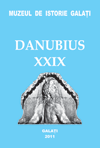Architecture and Private Space. The Mansion from Ghidigeni
Architecture and Private Space. The Mansion from Ghidigeni
Author(s): Marius MitrofSubject(s): Local History / Microhistory, 19th Century
Published by: Muzeul de Istorie „Paul Păltănea” Galaţi
Keywords: Chrissoveloni; biography; Ghidigeni; Galaţi; Greek family; agriculture; mansion; highlife
Summary/Abstract: Descending from an old family of archons from Chios Isle, Greece, Chrissoveloni family, through its representative, Zannis, arrived in Galaţi and settled here in 1848, laying down the bases of a cereal meter in the harbour. It was the starting point for the expansion of business in the Romanian space. Shorty after this establishment, the company was setting up agencies in Brăila and Bucharest. Businesses were successfully continued by Nicolas Z. Chrissoveloni, one of Zannis’ sons, who enlarges the family fortune by purchasing wide estates in Romania, Greece and Macedonia, Melnues-Monfort Castle near Paris, etc. In 1879, he bought from Dimitrie Mavrocordat, a renowned boyar of those days, Ghidigeni and Ciorăşti estate, being lured by its forests and soils favourable to cereal crops and vineyards, by its pastures and by the presence of Bârlad River and of a brandy distiller. Nicolae Chrissoveloni built in Ghidigeni a school, functional to this day, the village church, the mansion and its annexes on the banks of Bârlad. Around 1887, these had already been built. The mansion, a true palace, and its annexes, built by Nicolae Chrissoveloni, betrayed the influence of the Romantic architecture characteristic of the 19th century. The garden in front of the mansion, full of roses, was arranged in the French fashion, hosting rare species of ornamental bushes brought from abroad. Two water basins were adorning the mansion entrance, ensuring a fresh atmosphere in hot summer days, and outlining at the same time the residency status of the building. The bowling track and two tennis courts, out of which one was covered, were probably built after the beginning of the 20th century. Built on two levels, in the style of French academism, the architecture of the palace reminds of the Greek origin of the owner. This building, although with simple volumes of the wall elevation, impressed through the vertical rhythm ensured by the high, prismatic roofs suggesting medieval towers if the alert articulation of the decorative plastics did not partially dissolve their severity. During World War I, the mansion was turned into a hospital where Jean Chrissoveloni set up and managed Queen Maria Society of Ambulances. Nicky Chrissoveloni, together with his family, knew all the unfortunate events of the first half of the 20th century: the international crisis, World War II, confiscation of the fortune by the Communists, Communist prison. In 1960, he managed to leave, together with his family, in Greece. Ghidigeni mansion underwent the same hardships as Nicky Chrissoveloni. Burnt down by a fire in 1936-1937, it was rebuilt afterwards without preserving the same superb roof. In 1948 it was nationalised, turned into an agricultural establishment, then into a school for children with special needs. It suffered numerous transformations, both the palace and the annexes, and its state of degradation advanced continuously.
Journal: Danubius
- Issue Year: XXIX/2011
- Issue No: 1
- Page Range: 325-348
- Page Count: 24
- Language: English

